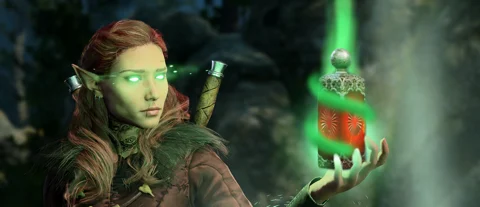Baldurs Gate 3 offers a ton of variety in everything, and damage types are no exception. Find out what the differences between all 13 damage types are here.

If you've been wondering how Baldur's Game 3's fighting system works, then you have come to the right place!
Baldur's Game 3's game system is based on Dungeons and Dragons and so is its combat. And just like in DnD, not only do players deal different kinds of damage, but they can also be resistant or immune to specific damage types as well. But how does that work?
Baldur's Gate 3: All 13 Damage Types
Physical
Physical damage can be sorted into three subcategories: Bludgeoning, Piercing and Slashing. This depends on the type of weapon you are using. Most enemies will not react differently to these subcategories, but some will.
Bludgeoning
Bludgeoning refers to damage applied by blunt weapons.
Piercing
A sharp, thrusting weapon does Piercing damage.
Slashing
An edged weapon, such as a Greatsword, can be used to deal slashing damage.

Cold
One of the most common types of damage, besides physical, is Cold. This can be dealt by Cantrips or Spells, such as Ray of Frost or Cone of Cold.
But, just as common as this damage type is, so is the amount of characters that are resistant to it. One of the five Ranger class features, Wasteland Wanderer: Cold, grants Cold resistance, for example.
Fire
The most common non-physical damage type has to be Fire. Actions, such as Fangs of the Fire Snake, which is a ranged attack that deals 1d4 damage to foes, or Embrace of the Inferno, which deals 2d6 damage, are possible uses of fire attacks. A popular Cantrip that can be used by wizards and sorcerers is Fire Bolt, a ranged 1d10 attack.
Just as is the case with Cold, Fire damage's popularity also means, that many enemies are resistant to it. Many demons and devils are amongst those resistant to Fire, as well as those that are fire elementals. Besides that, one way to gain fire resistance is a Ranger class feature, Wasteland Wanderer: Fire. Tieflings with Hellish Resistance also gain Fire resistance.
Acid
While Acid isn't necessarily a rarely used damage type, much fewer opponents have a resistance to it than to Fire or Cold. Popular uses of Acid damage are the Cantrip Acid Splash and the level 2 evocation spell Melf's Acid Arrow.
The great thing (or bad thing, depending on which end of the attack you're on) about Acid spells, is that they leave behind Acid pools, which can hurt nearby characters as well. If a player doesn't wash it off, the Acid stays on them and continues to deal damage.
Possible resistance types to acid are through black or copper Draconic Ancestry or via elemental adept.
Lightning
Unlike Pokémon where an electric type Pokémon can use lightning and thunder(bolt) attacks, in Baldur's Gate 3, they count as different damage types.
Lightning attacks use, you guessed it, electricity to harm its targets.
Possible Lightning attacks are Call Lightning, which is a level 3 Conjuration Spell that does 3d10 damage or Lightning Bolt, a level 3 Evocation Spell that does a whopping 8d6 damage.
But, just like Fire and Cold, there are a lot of characters that have Lightning Resistance.
Force
Force damage is quite rare, and resistance to it is even rarer.
Force damage is just physical damage done by magic. Magic Missile is a level 1 Evocation Spell that deals 1d4 Force damage, and Eldritch Blast is a level 1 Cantrip that can deal 1d10 Force damage.
Some attacks will deal Force damage along with a different damage type, such as Smokepowder Surface, which deals both 2d6 Fire and 2d6 Force damage.

Poison
While Poison damage may not be weaker than other damage types, it can be hard to use it as much as you wish you could.
Many foes have a resistance to Poison. Undead and Constructs (creatures that were made instead of born) are fully immune to Poison.
If you do get the chance to attack your opponent with a Poison spell, Poison Spray is a good option, as it is a level 1 Cantrip that deals 1d12 of damage. Ray of Sickness is a good option too, which is a level 1 Necromancy spell that deals 2d8 of damage.
Thunder
While we can't imagine thunder without lightning in real life, in BG3 it's possible. While Lightning damage is produced by electricity, Thunder damage is created by using shockwaves as an attack.
Luckily, Thunder resistance is very rare, so if you have a Thunder spell that you wield, chances are quite high you will deal a good amount of damage with it.
Thunder damage can only be dealt with a spell, as there are no Thunder Cantrips in the game. A level 1 Evocation spell that deals 2d8 Thunder damage is Thunderwave.
If you can access level 5 Evocation spells, Destructive Wave will deal 5d6 Thunder damage, as well as 5d6 Radiant damage.
Radiant
Speaking of Radiant damage, a popular attack dealing 1d8 Radiant damage is Sacred Flame, a level 1 Evocation Cantrip.
Unlike Poison, many undead are vulnerable to Radiant damage. In general, Radiant resistance is quite rare.
Necrotic
If you want to feel like the grim reaper, this damage type is for you! Necrotic damage literally uses the power of death, so it won't work on undead (weird, I know) or objects (again, who would've guessed) or on Constructs.
If you are looking for a Cantrip that deals Necrotic damage, then you will want to use Bone Chill, which deals 1d8 of Necrotic damage.
Otherwise, if you are hoping to deal even more Necrotic damage, check out Blight, a level 4 Necromancy spell that can deal 8d8 damage.

Psychic
And finally we've arrived at Psychic damage. Probably one of the first types of damage we encounter in BG3, as Mind flayers deal Psychic damage. While Psychic attacks don't usually deal as much damage as other attacks do, they do leave behind pretty useful status effects most of the time.
Like Phantasmal Force, which deals 1d6 Psychic damage the first time you attack. But every round after that, if the target is damaged by another source, Phantasmal force will also deal 1d6 of damage that the new attack dealt.
The only available Psychic Cantrip is Vicious Mockery, which only deal 1d4 damage, but gives the target a disadvantage on its attack rolls.
As great as all these damage types may be, not all of them might do as much damage as you think they will, if your enemy has a resistance to the type of damage your attack deals.
Damage Vulnerability, Resistance and Immunity
Well, depending on who you're fighting, they may have an advantage or disadvantage against your attacks. In order to find out which situation you're facing in a fight, you can open up the interaction menu and click examine.Once this opens up, you can see a bunch of important information about the character, but in this case we want to look at the character's resistances.If there is nothing listed under this category, then they have no resistances or vulnerabilities. But if they do, then here is how you can find out what type of resistance you are facing.
Vulnerability
If a character is vulnerable to a specific type of damage, a red arrow pointing down will appear above the damage icon in question.If a character is vulnerable to a damage type, they will take double the amount of damage from these types of attacks.
Resistance
A creatures' resistance to a damage type is indicated by a blue or white arrow pointing up over the damage icon.
One arrow shows that this character is resistant to damage from non-magical sources. If it shows both arrows, then that means that the opponent is resistant to damage from magical and non-magical sources.Resistance means that a character's total damage will be halved.
Immunity
Immunity is shown through a gold outline around the damage type.If the character is immune, then they take zero damage from attacks of this type.
So, the next time you play Baldur's Gate 3, remember to check your opponents stats! And if you can't remember what the symbols mean, you can always check it out here!






























